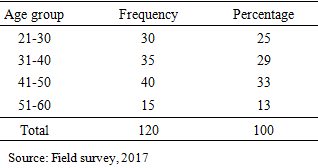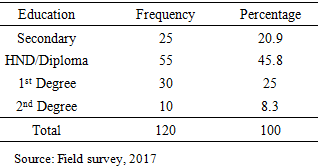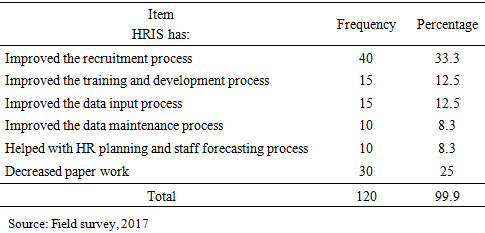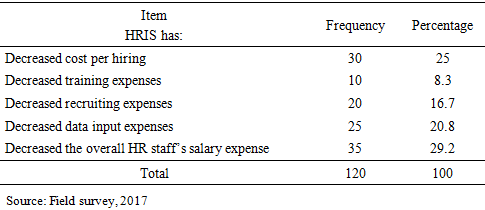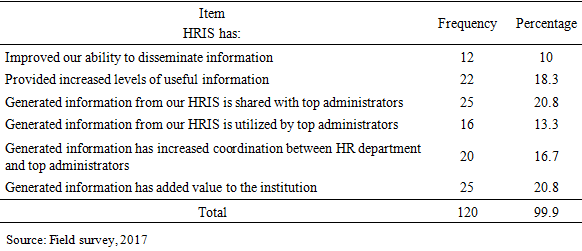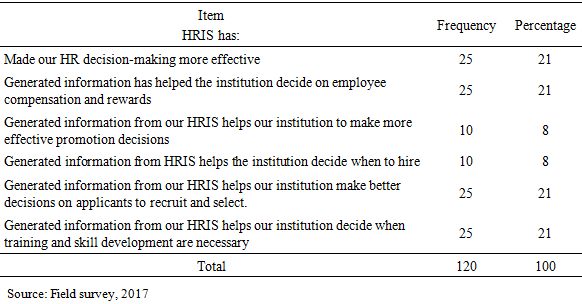-
Paper Information
- Previous Paper
- Paper Submission
-
Journal Information
- About This Journal
- Editorial Board
- Current Issue
- Archive
- Author Guidelines
- Contact Us
Human Resource Management Research
p-ISSN: 2169-9607 e-ISSN: 2169-9666
2020; 10(1): 13-21
doi:10.5923/j.hrmr.20201001.02

Making a Case for the Use of Human Resource Information System in Ghanaian Organizations: Views of Employees of Anglogold Ashanti Iduapriem Mine Limited
Bernard Arpoh-Baah1, Daniel Odoom2, Augustine Osei Boakye1, Isaac Okyere3, Christian Boateng4
1Faculty of IT Business, Ghana Technology University College, Takoradi Campus, Ghana
2Graduate School, Ghana Technology University College, Takoradi Campus, Ghana
3Faculty of IT Business, Ghana Technology University College, Koforidua Campus, Ghana
4Tarkwa Nsuaem Municipal Assembly, Tarkwa, Ghana
Correspondence to: Daniel Odoom, Graduate School, Ghana Technology University College, Takoradi Campus, Ghana.
| Email: |  |
Copyright © 2020 The Author(s). Published by Scientific & Academic Publishing.
This work is licensed under the Creative Commons Attribution International License (CC BY).
http://creativecommons.org/licenses/by/4.0/

This study examined the contributions of Human Resource Information System (HRIS) to the Ghanaian organizations, with a particular emphasis on Anglogold Ashanti Iduapriem Mine Limited using the quantitative research approach and the descriptive research design. The target population was the employees of the Company, with a total of 201 respondents selected based on simple random sampling method and a response rate of about 60%. A set of questionnaire was used to collect data for the study whilst frequencies and percentages were used to analyze the collected data. The study found that HRIS in the Company has proven to be very useful. For example, time spent on recruiting, training, data inputting, processing of documents, etc. has reduced due to the introduction of HRIS in the Company. Also, HRIS has led to cost savings in the Organization in areas including recruiting, hiring and training of employees, as well as data inputting. Again, HRIS has contributed to effective dissemination and utilization of information in the Company. Further, HRIS has enabled the Company to take effective decisions on issues such as compensation and rewards, promotions, training and development, and recruitment and selection of the best applicants. Based on the findings of this study, the researchers believe that there is a case for the use of HRIS in organizations. It is, therefore, recommended that other organizations in Ghana and beyond should pay increased attention to the use of HRIS due to the benefits they stand to gain.
Keywords: Human resource information systems, Human resource management, Employee
Cite this paper: Bernard Arpoh-Baah, Daniel Odoom, Augustine Osei Boakye, Isaac Okyere, Christian Boateng, Making a Case for the Use of Human Resource Information System in Ghanaian Organizations: Views of Employees of Anglogold Ashanti Iduapriem Mine Limited, Human Resource Management Research, Vol. 10 No. 1, 2020, pp. 13-21. doi: 10.5923/j.hrmr.20201001.02.
Article Outline
1. Introduction
- Human resource (HR) forms an essential component of both organizational and national development efforts. There is no gainsaying the fact that HR is the life-blood of every organization and nation. HR is what gives organizations and nations competitive advantage (Taher and Arifen, cited in Amegatsey, Odoom, Arpoh-Baah and Okyere) [1]. Human beings are the only element with the innate power to generate value. All other variables provide nothing but torpid potential. By their nature, all other variables add nothing, and they cannot add anything until some human being leverages that potential by putting them in motion (Fitz-enz) [2]. For example, Gyabaah, as cited in Odoom [3], opines that governments will be unable to reap economies of scale due to poor HR capacity. Globally, efforts are being made to ensure that organizations position their HR to reflect the ever-changing needs of society. One strategy in ensuring improved management of HR is the adoption of Human Resource Information System (HRIS). HRIS is a software or online solution that is used for data entry, data tracking and the data information requirements of an organization's Human Resources Management (HRM), payroll and bookkeeping operations. An efficient HRIS facilitates the administration of all staff data, reporting and evaluation of staff data, company-related records, including staff handbooks, disaster evacuation methods and security recommendations, rewards management, such as enrollment, status modifications and updating of personal data. HRIS has also been described by Rouse, as cited in Boateng [4] as an information system that provides a single, centralized view of the data that a Human Resource Management (HRM) or Human Capital Management (HCM) group requires for completing HR processes including recruitment, placement, payroll management and other HR practices. HRIS may also be viewed as a way, through software, for businesses big and small to take care of several activities including solutions in recruiting, training and payroll (Boateng) [4]. HRIS allows companies to plan their HR costs more effectively, as well as to manage them and control them without needing to allocate too many resources toward them. In most situations, HRISs may also lead to increases in efficiency when it comes to making decisions in HR. Consequently, the HR practitioners save many hours of their day instead of spending these hours dealing with non-strategic, mundane tasks required to run the administrative side of HR. Scholars including Ball [5] and Boateng [4] contend that there is quality in decisions and the overall productivity of both employees and managers through the use of HRIS. Results in companies increase and become more effective. In essence, HRIS enables companies to plan their HR costs more effectively, and also manage and control them without having to spend too many resources on them Boateng) [4]. The persistent pressure to reduce HR costs has resulted in reduced HR staffing, benefits slashing, and decreased HR services. HCM is now a story about how to reduce the ratio of HR staff to employees. When HRIS is integrated to the Enterprise Resource Planning (ERP) solutions, organizations can enjoy the ultimate benefits of an all-in-one system that can decrease errors, lower cycle times, reduce turnaround time, and ensure efficiency in management decisions (Teotia, cited in Boateng) [4]. In Ghana, deliberate strides have been taken to get every part of the country embrace improved technologies. Successive governments see ICT as a potent driver towards economic and social development (GOK – Ministry of Information, cited in Boateng) [4], hence the National ICT Policy 2006. HRISs have been put in place to introduce value driven competency based HRM practices. The HRIS implementation team for Capacity Ghana has championed the use of HRISs in Ghana since 2009. In 2010 the team collaborated with the Ministry of Public Health and Sanitation to ensure all HR data for hiring, training, transferring and retiring health workers were electronically entered into HRISs by the complement section. However, continuous monitoring and evaluation is vital in determining whether results are being achieved and what needs to be improved. Once HRIS has been implemented by an organization, management needs to assess how successful it has been in achieving its strategic goals. Many organizations find it a herculean task to objectively assess key policy decisions and actions including HRISs they undertake and may take an informal approach to evaluation (Stair et al., cited in Boateng) [4]. A few organizations dispassionately attempt to empirically measure the effectiveness of their information systems or even know how to do so (Stair et al., cited in Boateng) [4].In an attempt to deepen the discussion, Mohammed, as cited by Boateng [4], submits that evaluation of HRIS should determine whether HRIS is performing up to its expectations and if it is being used to its full advantage and return on investment. Though the demand for useful measures for assessing the overall opportunities of information systems investments has long been acknowledged, there is neither any one acceptable nor overall framework that organizes the important aspects of effective HRISs in a way that supports implementation of HRISs and influence. The single available option is by looking through the lens of well - known theories and model of information system (IS) effectiveness, by which the value of HRISs can be usefully assessed. It follows then that when assessing the impact and effectiveness of the HRISs at the various sectors such as the Ghanaian mining sector, one should be guided by, among others; whether or not there is reduced amounts and costs in HR data storage; improvements in time and accuracy; improved service standards; performance management together with proper training and development initiatives and improved status of the HR function (Gupta) [6]. Otieno, as cited by Boateng [4], strengthens the debates on HRIS by asserting that regular assessment of HRMIS is necessary to establish organizational performance and return on investment (ROI)’. In many organizations, the focus of HRIS is on administrative efficiency. However, suffice to posit that as organizations seek to grow and compete in the rapidly changing knowledge-based economy, the pressure continues to grow for HR to play a more strategic role towards organizational goal attainment. Consequently, there has an ever-increasing need to ensure growing link between HR and business strategy. Organizations continue to look to their HR professionals and managers for more innovative programs and practices to build a more competitive workforce in order to achieve the reason for their existence (Muriithi et al., cited in Boateng [4]; Nawaz and Gomes) [7]. Despite the increasing functionality and affordability which allow for HRISs to be used extensively in both public and private organizations, very limited research exists on the place of HRIS especially in developing nations such as Ghana. Available research on the disparities existing and the impact of HRISs on the general performance of organizations. A study of the role of HRISs in HR Planning revealed research gaps that organizations which embrace HRIS systems and policies seem to achieve in respect of their administrative functions (Opoku-Mensah) [8]. Opoku-Mensah [8] argues that though the existing HRISs can optimally contribute to the performance of both public and private organizations, some organizations including the Ghanaian mining sector do not fully utilize HRIS for recruiting, training, payroll and performance management. Reasons accounting for the prevailing situation include over-dependence on traditional methods and poor awareness of HRISs. Besides, some organizations do not utilize HRISs and policies due to lack of funds to upgrade the system with required features. HR has been described by many scholars as the most valuable resource of an organization. Despite the complex nature of human capital, which is their personality, character and the ability to achieve goals, people differ in all aspects. The ability of traditional HR function cannot adequately provide effective and efficient planning of the HR needs regarding paid leave, pension, succession plan, recruiting talented employees. The lack of systematic approach to HR planning accounts for such challenges. Mention can be made of issues such as inadequate qualified personnel in the right place, at the right time to deliver high quality; and value for money services in partnership with communities (Boateng) [4]. The poor planning habit is due to manual approach of gathering information about the employees to access their needs on time. Private and public services in Ghana have a large number of HR base in the country and it is estimated at 60% of the total workforce. Despite this large percentage of estimated total workforce, HR activities are still being performed using manual processes and approaches. The effects of using these traditional approaches include low productivity and inefficiency in operations. These factors coupled with rapid advances in technology have implications on what and how services are provided, to whom, and at what cost. The seeming unwillingness of organizations to embrace HRISs presents a huge challenge to the continuing relevance of HRISs to organizations. It is against this background that the study sought make a case for the use of HRIS in Ghanaian organizations using by investigating the views of employees of Anglogold Ashanti Iduapriem Mine Limited on the contributions of HRIS to the performance of the organization.
2. Review of Literature
2.1. The Concepts of Human Resource and Human Resource Management
- Drucker [9] was the first person to have used term HR in the practice of management. His concept of HR was crafted as a result of the discussion of the management of workers and work. Also, his concept placed more emphasis on human capacity. He argues that HR possesses a unique quality that cannot be seen in other resource such as “the ability to imagine”. Unlike other resources utilized by managers, the HR can only utilize itself. The human being has absolute control over whether he works at all. It was again argued to implore managers to be human centered in their design of work by taking positive actions that would motivate their employees and create challenging jobs that would develop their workers (Boateng) [4].Drucker [9] criticizes personnel management discipline and outline three basic misconceptions. These are: it assumes people do not want to work; it looks upon the management of work and the workers as a specialist job rather than a key part of any manager’s job; and it has a tendency to be firefighting and troubleshooting activities other than focusing on positivity. According to Storey [10], ‘Human Resource Management (HRM) has become a key element of business school and has a major focus of management research’. HRM has replaced personnel management and in many institutions, it has taken over industrial relation and organizational behavior. Their formation was in reaction to what we called “Industrial Better”. Ivancevich [11] stated that Personnel Department begun to appear in an organization around the 1910s due to the growth of organizations and were concerned with doing something about conflict between employees and management (Boateng) [4]. Traditionally the function of the Personnel Management is aimed to ‘hire and fire’ employees in organizations other than salary payment and training. There was a clear-cut difference between Personnel Management and HRM. This was seen as a result of criticism and concerns of ambiguity that was expressed about the purpose and roles of these two elements (Tyson) [12]. Therefore, HRM gradually replaced the term Personnel Management (Lloyd and Rawlinson) [13]. However, some writers are of the view that HRM is no different from personnel management since both have the same functions such as organizing and motivating human resources required by institutions or organization. In contributing to the discussion on HRM, Noon [14] asserts that the term ‘HRM replaced personnel management due to the changes and evolution in the world of management and therefore it was appropriate to use the term HRM as way of incorporating new ideas, concept and philosophies of Human Resource’. Legge [15] stated that ‘some writers are of the view that there is little difference between Personnel Management and HRM and normally referred to it as ‘old wine into new bottle’ and given a new label’. HRM therefore began in the early 1800 in the era of craftsman and apprenticeship in England. It later developed during the season of Industrial Revolution in the 18th Century and it substituted hand labor with steam power and machinery. Therefore, changes in working conditions and emergence of supervisors or foremen who were not necessarily the owners of the business were the forerunner of HRM. Armstrong [16] defines HRM as a planned and coherent approach to the management of an organisation’s most valued assets-the people. Rowley and Jackson [17] take rather a broad and more inclusive view of the concept of HRM. The authors broadly define HRM as the management of people. This includes managing people in terms of recruitment and selection, rewards, training and development, and the building and sustaining of relationships such as employment relations. HRM refers to the management function which enables managers to recruit, select, train and develop members for an organization. Simply put, HRM is concerned with the people’s dimensions in organizations. HRM refers to set of programs, functions, and activities designed and carried out. The core elements of HRM are people, management, integration and consistency, influence and applicability. People refers to the individuals who staff and manage organizations whilst management entails the application of management functions and principles for acquisitioning, developing, maintaining and remunerating employees in organizations. Integration and consistency relate to decisions regarding people which must be effectively integrated and consistent. Also, decisions must influence the effectiveness of organization leading to better services to customers in the form of high quality products supplied at reasonable cost. Again, HRM functions are applicable to business as well as non-business organizations too, such as education, health, recreation and the like (Raghubar) [18].From the above, HRM can be explained as consisting of all management functions which concern people. It is about practices, policies and measures put in place by organizations in order to effectively bring the best out of the people aspect of the organization. The history of HRM can be traced to the 19th century, when some enlightened industrial firms in the US and Europe employed welfare officers to look after the wellbeing of workers, especially women and children. In the 1920s and 1930s firms employed labor managers to handle pay, absence, recruitment and dismissal. Around the late 1940s labor management and welfare work became part of ‘personnel administration’ and throughout the 1970s and 1980s, personnel administration became ‘personnel management’ and eventually ‘HRM’ due to the increasing recognition of HR to the success of organizations. Many companies regard the ‘people’ function very much and even call their most senior HR executive the ‘chief people officer’ (Shapiro et al.) [19]. According to Henneman et al. [20] and Werther et al. [21], HRM is a new synonym for Personnel Management, the management of employees by specialist staff. HRM can be defined as a distinctive approach to employment management which seeks to achieve competitive advantage through the strategic development of a highly committed and capable workforce using an integrated array of cultural, structural and personnel techniques (Storey) [10]. Also, according to Armstrong [22], the people who work individually and collectively in organizations need to be properly managed. That, it is the management of people to ensure organizational goal achievement which is known as HRM. Byars and Rue [23] have also defined HRM as a system of activities and strategies that focus on successfully managing employees at all levels of an organization to achieve organizational goals. This implies that management philosophy is consistent with the view that all employees are valuable organization resources rather than expenses which the human resource department should assist in minimizing. In every organization, employees are the human resource and they are the most valuable resource. For every organization to be successful employee productivity must be made a major goal. This can be achieved through motivation, training and development etc. The level of productivity can vary depending on the skill and educational level of the employees. In developing a high performance and very effective and skilled workforce, the organization should employ the use of human resource management input.
2.2. Conceptualizing Information System and Human Resource Information System
- Information is critical in organizational performance. Employees and employers all need information in order to take appropriate decisions and actions for the overall good of the organization. Information is a powerful resource which should be viewed and utilized as such. In support of this position, McLeod [24] contends that information is one of the major types of resource available to supervisors and line managers. It can be managed just as any other resources, in fact business has become more complex and the computer has achieved improved capability in processing of information. Information output processed by computer is used by persons and organizations within the firm’s environment. The firm is a physical system, but it is mostly managed with conceptual systems which consist of information processors that transform data into information and represent the physical resources. Information System includes a look back at how hardware has evolved and has been applied with the passage of time. Since the installation of the first general-purpose digital computer in a business organization, hardware has undergone manifold increase in speed and in capacity. Computer applications have evolved from relatively straight forward accounting processes to system designs to support individuals and other problem solvers (Boateng) [4].An information system is a software system to capture, transmit, store, retrieve, manipulate or display information thereby supporting people, organization or other software systems. An information system may support not only an organization or a person but also other software systems. The information available to organizations is growing at an exponential rate and that information explosion is evident in all parts of our lives. The instant access to ‘what we want to know, when we want to know it’ is paramount to many things that we do. Therefore, business organization is not an exception. People are a complex resource to manage and the variety of employee contractual terms, attendance patterns, skills and experience demand increasingly sophisticated HRIS if the organization is to maximize the competence and flexibility of employees (Alter, cited in Boateng) [4]. Gill and Johnson [25] see HRMIS as a process which utilizes the information technology for the effective management of human resource functions and applications. It is a computerized system typically comprising a database or interrelated database that track employees and their employment specific information.According to Hendrickson [26], HRIS is an integrated system used to gather, store and analyze information regarding an organizations human resources comprising databases, and computer application. It also about hardware and software necessary to collect, record, store, manage, deliver, present and manipulate data for HR functions. Parry [27] stated that HRIS performs a number of functions ranging from simple storage and communication of information to a more complex transaction. HRIS functions increases as technology advances with time. HRIS is centered on HR department but HRIS usage provides a number of benefit or it advantageous not only to Human Resource function but the organization as a whole. Beadles, Lowery and Jones [28] stated that HRIS use has been advocated as an opportunity for HR professionals to be strategic partners with top management. It allows HR functions to become more efficient and provide better information for decision making. Although HRISs were computerized and were having extensive growth in size and scope, they remained simple record-keeping system (Kavanaugh et al.) [29]. Kovach et al. [30] considered HRIS as a systematic procedure for collecting, restoring, maintaining and recovery data required by an organization about their human resources and organizational characteristics (Kovach et al. [30]; Kovach et al.) [31]. HRIS has two extremes in examining its benefits to HR, the pure administrative use of HRIS and its strategic use but their ultimate goal is to increase organizational value. The efficiency and administrative effectiveness of HRIS can be describe by studies of administrative HRIS but the overall efficiency and effectiveness of an organization can only be reach through strategic deployment of the information provided by HRIS (Kovach et al.) [31].The increasing pressure to support strategic objective of companies coupled with the greater focus on shareholder value has led to changes in both job content and expectations of HR professionals (Ball) [5]. According to Schuler et al. [32] and Mayfield et al. [33], one of the major changes included contemporary use of information systems and support of HRM processes. A careful study shows that the increase in usage of HRIS has improved performance of employees and thus facilitated involvement in internal consultancy activities. Most organizations are now placing importance on human element by seeking to empower their employees, provide opportunities for training development and foster the spirit of partnership and team work to increase performance. HRIS is one of the most important used information system facility because it helps companies to achieve their objective more easily and effectively. These systems are needed in every sector of which the industrial sector is not an exception. Particularly, this has been occasioned by the fear of competition which requires the need to ensure the efficiency and effectiveness of HR to harness the limited available resource for improve productivity and service quality through controls and cost reduction strategies (Boateng) [4].
3. Research Methodology
- The study relied on the quantitative research approach and the descriptive design in order to provide a framework to examine current conditions, trends and status of events. Descriptive research design is more investigative and focuses on a variable factor. It is analytical and often single out a variable factor or individual subject and goes into details and describing them. The study adopted descriptive research design in order to provide a framework to examine current conditions, trends and status of events. According to Koranteng, as cited by Boateng [4], a descriptive research is designed to find out the existing situation of a phenomenon of concern. In support of Koranteng’s contention, Amedahe, as cited in Odoom, Opoku and Ntiakoh-Ayipah [34], descriptive design determines the nature of prevailing conditions, practices, attitude, opinions held by persons, processes of doing things and trends that are developed. In descriptive research, the events or conditions either already exist or have occurred and the researcher mainly selects the relevant variables for an analysis for their relationships. This type of research is a systematic attempt to collect information from members of an identifiable population, particularly, staff of organizations. The rationale for using the descriptive survey is that it helped in telling what the exact situation was in a systematic manner (Opoku-Mensah) [8]. The target population was the employees of the Company because the use of HRIS affects every individual in an organization. There was a total of 420 employees in the Anglogold Ashanti Iduapriem Mine (Human Resource Records) [35]. Based on Krejcie and Morgan [36] sample size determination table, 201 employees were selected from a population of 420 at a 95% confidence level. However, the response rate during the data collection stage was approximately 60%. A set of questionnaire was used to collect data for the study whilst frequencies and percentages were used in analyzing the collected data. Tables were used to present the findings and the results were discussed in the context of previous studies.
4. Results and Discussion
- The findings of the study were presented and discussed based on two considerations. The first has to do with the demographic data of the respondents, whilst the second deals with issues based on the aim of the study. With regard to the demographic data, issues such as sex distribution, age and educational qualifications are presented. As already indicated, 120 employees of AngloGold Ashanti, Iduapriem Mine, Tarkwa that responded to the questionnaire were examined. This gave a response rate of approximately 60 percent. Table 1 presents the sex distribution of respondents. From Table 1, it is clear that 67% of the respondents were males whereas 33% were females.
|
|
|
|
|
|
|
|
5. Conclusions and Recommendations
- The study aimed at exploring the contributions of HRIS in organizations in Ghana, with Anglogold Ashanti Iduapriem Mine Limited as a case for analysis. The time spent on recruiting, training, data inputting, processing of documents and making staff decisions has reduced with the introduction of HRIS in the Organization. HRIS has led to cost savings in the Organization in areas including recruiting, hiring and training of employees, as well as data input expenses. Again, HRIS has contributed to effective dissemination and utilization of information in the Organization. HRIS enables the Company to take effective decisions on issues such as compensation and rewards, promotions, training and development, and recruitment and selection of the best applicants. On the whole, HRIS improves the HR processes such as employee recruitment and selection, training and development, HR planning and staff forecasting, data inputting, data maintenance and reduced paper work in the Organization. Essentially, there is a case for organizations to embrace HRIS in ensuring goal attainment. In essence, the researchers recommend that other organizations in Ghana and beyond should pay increased attention to the use of HRIS due to the benefits they stand to gain. Organizations which are yet to embrace HRIS are to do so on the basis of the associated benefits they are likely to enjoy.
 Abstract
Abstract Reference
Reference Full-Text PDF
Full-Text PDF Full-text HTML
Full-text HTML
